#jacob grimm ii
Explore tagged Tumblr posts
Text
in dire need of uncle Jake and puck content they are Duo Of All Time to Me (altho I have the softest of soft spots for Puck and Granny Relda I’ll be honest)
18 notes
·
View notes
Note
in source i killed my dad but its. not even a cool "i hate my dad" revenge thing i was just stupid & a kid & wanted to help my brother by getting him & his girlfriend get out of town (via letting down a magic barrier. its Complicated) but in doing so the fucking. JABERWOCKY killed my dad. like i feel so guilty & i miss him to this day. sorry dad - jacob "jake" grimm ii
damnnn that sucks. my day be so fine then boom jabberwocky
11 notes
·
View notes
Text
The Romanticism of One Piece II: Fairy Tales
Part I Part III AO3
“I long to see the blue flower” --Novalis
In 1812, brothers Wihelm and Jacob Grimm published their first volume of fairy tales. The book was not initially meant to be read as purely children’s stories, but as a collection of tales they felt reflected German culture. They weren’t alone in their study of folk culture and stories, as interest revived throughout the Romantic period, particularly in Germany.
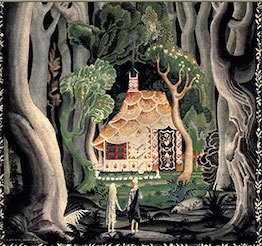
Later editions of the Grimm’s fairy tales, however, were changed to be more suitable for younger audiences. There was something about the stories that captured the mind of a child, and the expansion of children as their own demographic to be catered to encouraged publishers to specifically produce works for younger audiences. I feel like CS Lewis said it best while defending his own use of fairy tales, “He [the person reading fairy tales] does not despise real woods because he has read of enchanted woods: the reading makes all real woods a little enchanted”. The Romantics of this era were themselves enchanted by the power of these stories, and utilized them to great effect in their works.
Romanticism gets its name from the medieval ballads that were popular during the time period, themselves written in the romantic languages. Artists drew heavily from a mythologized past for their paintings, and writers such as Goethe and Novalis wrote literary fairy tales of their own inventions, drawing upon allegory and metaphor to express their philosophical ideals. In 1813 Percy Bysshe Shelly wrote a revolutionary and radical tract in the form of a poem and fairy tale, named after and heavily featuring Queen Mab. These men, along with the Brothers Grimm followed a tradition set by the “discovery” of Ossian, an epic poem that presented itself as the Gaelic equivalent of the Iliad or Odyssey, but was largely an invention of the poet James Macpherson.
One Piece is chalk-full of allusions to fairytale and myth. The manga opens with the grand execution of Gold Roger, his final words the sort of promise that you could easily see becoming a campfire story today, a whispered rumor and legend of impossible treasure for any person brave enough to go looking for it.

Oda starts leaning into real-world myth as early as chapter 23 with Usopp’s introduction, his name in part derived from the Greek storyteller Aesop and the plot a loose retelling of the Boy Who Cried Wolf, with his trademark nose being a clear reference to Pinocchio.
When looking at One Piece’s use of real-world myth and story, the thing that strikes me is how often Oda will borrow from the iconography of a story without simply rehashing it. Just about every major arc borrows in some way from real world children’s tales, but you’d be hard pressed to call Oda’s usage derivative. Even with the broad pool of references Oda draws from, the manga never would have lasted as long as it has if he’d just copied from the stories we’ve all heard since childhood.
For example, on Drum Island Chopper is a clear reference to Rudolph the Red Nosed Reindeer. Much like the Syrup Village before it, it draws directly on the themes of the original work, ostracization and rejection being primary motivators when developing Chopper’s arc.
But more than that, Hiliruk is introduced entering his unwitting patient’s houses through the chimney, just like Santa Claus, and Chopper’s repeated journeys up and down the mountain using the island’s rope system while pulling a sleigh is clearly borrowing from the iconography of Christmas. But you’d be hard-pressed to find anyone who would call Drum Island a Christmas story, even though it’s set on an appropriately wintery environment.

There are more examples. Laboon eating the Straw Hat’s ship could be seen as a reference to Moby Dick, Pinocchio, or the biblical story of Jonah, yet Reverse Mountain doesn’t share themes with any of those stories outside of the use of a mythical whale. The Skypiea Saga kicks off with the introduction of shadowy “giants”, before moving to a treasure hunt while befriending a young girl who plays a harp, and ends with the felling of a giant beanstalk. But does anyone really think of Skypiea as a retelling of Jack and the Giant Beanstalk?
My favorite of these has to be Alabasta, since I see so few people pick up on it. The entire climax of the arc involves a devilish crocodile, a man with a hook for a hand, a ticking clock, and the imposing presence of a giant clock tower that looks suspiciously like Big Ben in a setting otherwise influenced by Egyptian archeology. Why or how Oda decided to mix Peter Pan with his epic tale of friendship and betrayal amidst a war on a desert island is beyond me, but he did.
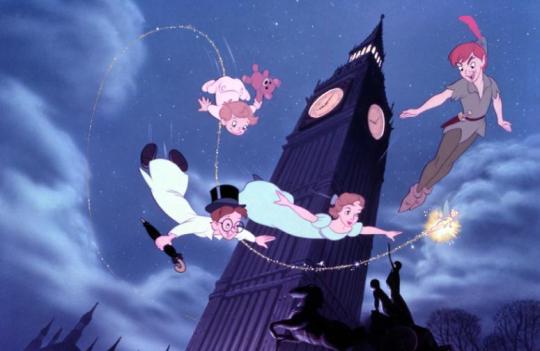
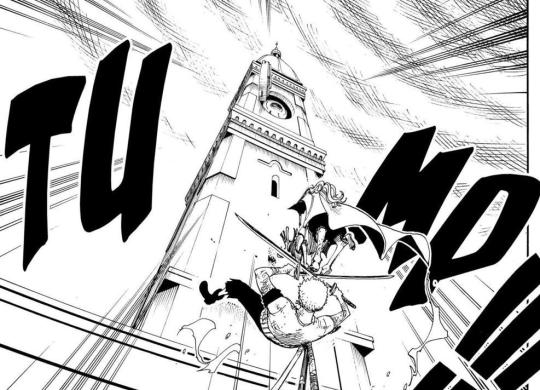
These examples aren’t only found pre-timeskip. I saw people able to guess who would live and die during Wano based solely on how closely Oda was following various Japanese fables, with broad plot elements being based on the famous story of Momotaro.
Of course, Oda doesn’t limit himself to fairy tale and myth. He frequently draws from history and pop culture at large, or, at least, the pop culture of his youth. Sanji’s design is based on Reservoir Dogs. All the Admirals share a face with Japanese actors. Thriller Bark is named after and directly homages��more than once!--Michael Jackson. Somehow you can have music video references sitting next to yokai, Frankenstein, the Invisible Man, and the Island of Dr. Moreau without cognitive dissonance, because that’s just how Oda writes. The Tree of Knowledge (the ‘of good and evil’ is implied) can coexist with Adam and Eve—which here are also trees—which can in turn overlap with Yggdrasil. The biblical ark Noah can exist in the same island as the Flying Dutchman, while the most biblically-coded of all the sagas can have an ark of its own while drawing many of its names and iconography from Eastern religions such as Shinto and Buddhism. That’s not when it’s drawing on Meso- and Native American iconography and religion instead. And somehow…somehow…it all gels together with the stories of El Dorado and Jack and the Giant Beanstalk.

Once one starts going down the rabbit hole of references and homage it becomes hard to stop. The interweaving of so many references, both obvious and not, while still maintaining an original plot boggles the mind. How Oda got the idea to mix Alice and Wonderland, Power Rangers, Aladdin, and fascist iconography while also turning Sanji into a Disney Princess is beyond me, and in my opinion, a large part of his creative genius.
But the question remains…why? Why reference Santa Claus on Drum, or Jack and the Giant Beanstalk in Skypiea? Some allusions make sense with the surrounding story, but others seem to be placed at random just because Oda could.
I think the answer falls back to the Romanticism of One Piece. Oda has said in many different interviews that he writes with an audience of children in mind, particularly young boys. By pulling from the stories of childhood he creates a frame of reference, and because Oda draws from a wide pool of sources that frame of reference can have a more universal appeal, fitting with his world-spanning, swashbuckling adventure. I was never told the story of Momotaro, but I know about the Boy who Cried Wolf. My grasp of Norse mythology is shaky at best, but I recognize the image of a reindeer pulling a sleigh through the night sky.
As I’ll get into later, the Romantics were obsessed with the innocence and experience of childhood. That was one of the reasons they were drawn so much to fairy tales. To them, stories that were spread amongst the common folk were the most pure form of culture, and it was from these stories that they strove to create a shared identity.
One Piece is a world-spanning tale, and the stories it references reflect that. But for as different as culture can be from country to country, or island to island, there’s a shared humanity in the stories we tell. A fairy tale will always feel like a fairy tale, whether it’s from Japan or Germany. And by immersing itself in these memories of childhood, Oda carves himself a place amongst these ancient stories
Marking the end of One Piece’s prologue, chapter 100 draws back from the immediate story to call attention to its own internal myth. Utilizing some Oda boxes quoting Gold Roger, the narrator writes, “These things cannot be stopped. An inherited strength of will, one’s dreams, and the ebb and flow of ages. As long as people hunger for freedom, these things will always exist”.
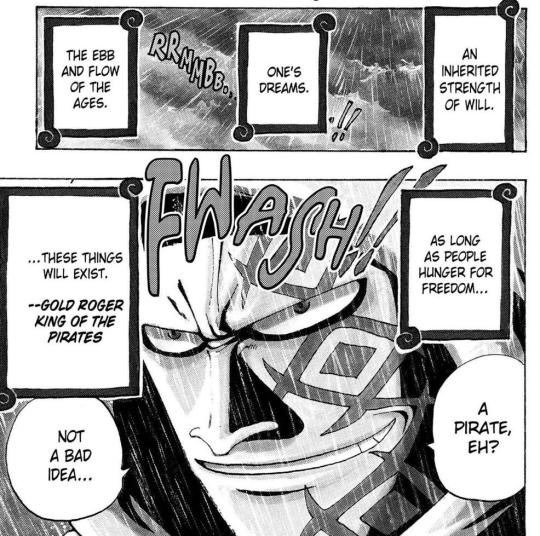
The name of chapter 100? The Legend Begins.
This isn't a coincidence. The Grand Line in particular is described in-universe as a land of fairy tales. The Little Garden and Elbaf arcs start with quotes from the explorer Louis Arnot. The cover of Brag Men, where these quotes come from, labels the book romantic fiction. Oda revealed in the SBS for volume 42 that the stories within the book are so outrageous and unbelievable to ordinary people that they’re believed to be untrue, much like the story of Noland the Liar.
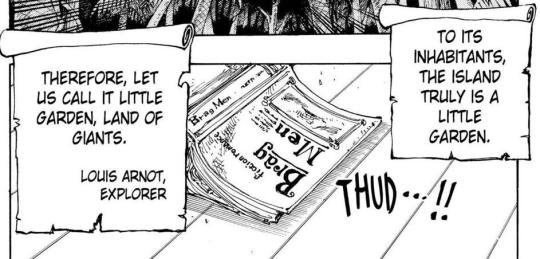
And yet, these are the stories that Luffy goes chasing after.
Now, I could send an age quibbling over the difference between a myth, a legend, and a fairy tale, but in the case of One Piece there’s enough overlap to be irrelevant. One Piece draws upon fairy tales because in many ways it is a fairy tale. It’s easy to imagine the entire story being told from Usopp’s perspective as he sits around the fire, telling his tale to a wide-eyed audience of children. Whether he’s telling the truth or not doesn’t matter, because it feels true, and for the first time the woods start to feel enchanted. And perhaps it’s that spark of magic that’s enough to stir the imagination of the next generation of dreamers to go out on adventures of their own, no matter how absurd and impossible.
146 notes
·
View notes
Text
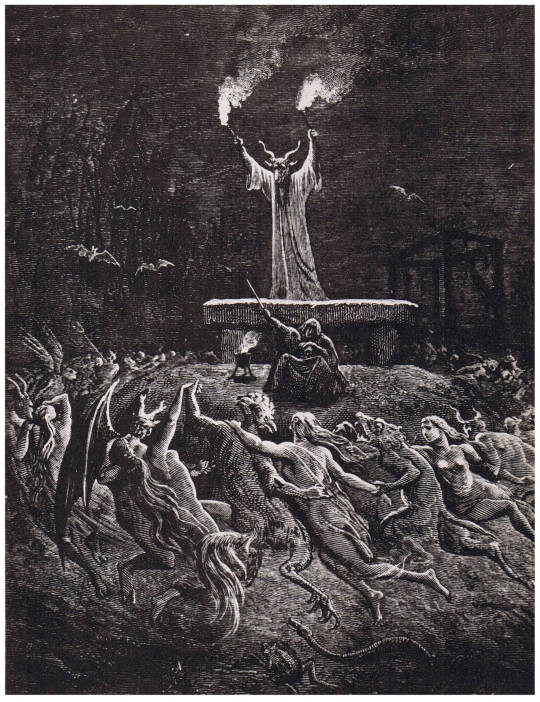
Walpurgis Night. Hexennacht. April 30.
A Short History of the Night of the Witches The origins of the image of Walpurgis night being a witches’ sabbath are unclear. However, it is striking that it coincides with Beltane and maybe other pagan festivals in earlier time. Goethe presumed in one of his poems such an origin.
St. Walpurga For Christians, Walpurgisnacht is also known as the Feast of Saint Walpurga, that is celebrated from the evening of April 30 to the day of May 1st. Saint Walpurga or Walburga was the daughter of St. Richard the Saxon Pilgrim and sister of St. Willibald and St. Winibald. When her father went on a pilgrimage with her two brothers to the Holy Land, he left Walpurga, who was only 11 years old at the time, with the nuns of Wimborne Abbey, where she was educated and learnt how to write.
She traveled in an attempt to bring German pagans to the Christian faith and she also authored Winibald’s biography, which is why she is considered as one of the first female authors in Germany and England. Walpurga became a nun in Heidenheim am Hahnenkamm, the monastery founded by her brother Willibald, where she became the abbess after his death in 751. Walpurga herself died on February 25 on 777 or 779 and she was canonized by Pope Adrian II on May 1st, around 870, when her relics were transfered to Eichstätt, Germany.
St. Walpurga is prayed to for protection against witchcraft and it is believed that during the night of April 30, she is able to ward off spells, witches, and evil spirits. This belief may stem from the overlapping of her canonization with Hexennacht or the Night of the Witches, the celebration that has its origin in ancient fertility celebrations. Hexennacht is a Germanic tradition more prevalent in the 17th century, when witches and sorcerers gathered together celebrate.
To protect against their magic, the Western Christian Church appointed the night of April 30 to St. Walpurga’s Feast. In the 18th and 19th centuries, Walpurgisnacht was popularized and its witchy connotations were revived through the literature of the time, such as in Jacob Grimm’s work who wrote in 1833: “There is a mountain very high and bare… whereon it is given out that witches hold their dance on Walpurgis night”.
Goethe also dedicated a poem to the celebration called “Die erste Walpurgisnacht” (The First Walpurgis Night), which was set to music by Felix Mendelssohn and published as his Opus 60 in 1843. The poem contrasts sharply with the Walpurgisnacht described in his main work “Faust”. In his ballad, Goethe relates the superstitions around Walpurgis night to the usage of devil’s masks by pagan’s in order to exploit the superstitions of their Christian suppressors and to protect their identities.
60 notes
·
View notes
Text
Deep dives into folklore: German folklore
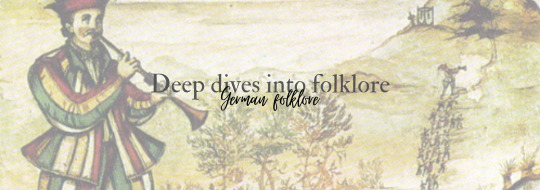
Embedded within the cultural fabric of Germany lies a trove of enchanting narratives, a testament to the nation's rich heritage and historical tapestry. German folklore, a captivating blend of ancient pagan beliefs, medieval epics, and timeless fairy tales, unveils a world steeped in myth and tradition. This essay embarks on a comprehensive exploration of German folklore, tracing its origins, introducing mythical figures, unraveling folk traditions, and assessing its profound influence on literature and popular culture. Within this intricate tapestry, the diverse tales of Germanic lore reveal not only the evolution of storytelling but also the enduring spirit that continues to captivate audiences across time and borders.
I. Ancient Roots and Pagan Influences:
Germanic folklore has its origins in the pre-Christian beliefs of the Germanic tribes. The pantheon of gods and goddesses, such as Woden (Odin), Thor, and Freyja, held sway over the imaginations of early Germanic people. The Eddas, epic poems preserved in Iceland, provide glimpses into the cosmology and mythology of the Germanic peoples, offering tales of creation, heroic exploits, and the prophesied end of the world, Ragnarök.
II. Germanic Mythical Figures:
The Nibelungenlied: The Nibelungenlied, a medieval German epic, tells the tragic tale of Siegfried, the dragon-slayer, and the curse surrounding the Nibelung treasure. This epic, with its themes of heroism, betrayal, and revenge, has left an indelible mark on German folklore and is a precursor to later literary works, including Wagner's operatic adaptation, "Der Ring des Nibelungen."
Brothers Grimm Fairy Tales: Perhaps the most famous collectors of German folklore, the Brothers Grimm, Jacob and Wilhelm, compiled a vast collection of fairy tales that have become timeless classics. Stories like "Cinderella," "Snow White," and "Hansel and Gretel" are embedded in global consciousness, showcasing the enduring appeal of German folk narratives.
III. Folk Traditions and Creatures:
German folklore is teeming with a diverse array of folk traditions and mythical creatures, each with its own regional variations. From benevolent spirits to malevolent beings, these entities populate the cultural landscape of Germany.
Kobolds and Elves: German folklore features kobolds, mischievous household spirits, and elves that are often associated with forests and natural landscapes. These beings, sometimes helpful, sometimes capricious, embody the close connection between the Germanic people and their natural surroundings.
The Lorelei: Along the Rhine River, the Lorelei is a legendary siren or mermaid who lures sailors to their doom with her enchanting song. This myth has inspired numerous poems and songs, becoming a symbol of the dangers and allure of the river.
IV. Impact on Literature and Popular Culture:
German folklore has left an indelible mark on literature and popular culture, both within Germany and globally. Beyond the Brothers Grimm's fairy tales, Germanic mythology has influenced literary giants like J.R.R. Tolkien, whose Middle-earth draws inspiration from Norse and Germanic mythologies.
Wagner's Operas: Richard Wagner's operatic masterpieces, including "Der Ring des Nibelungen" and "Tristan und Isolde," draw heavily from Germanic mythology. Wagner's reinterpretation of these myths has become iconic in the world of classical music and opera.
Contemporary Fantasy: German folklore continues to influence contemporary fantasy literature and film. Authors and filmmakers often draw on Teutonic themes to create worlds filled with magical creatures, quests, and epic struggles between good and evil.
German folklore stands as a testament to the enduring power of storytelling in shaping cultural identity. From ancient pagan beliefs to the enchanting tales of the Brothers Grimm, the narratives of German folklore have transcended time, leaving an indelible mark on literature, art, and popular culture. As these tales persist and evolve, they provide a window into the collective imagination of the Germanic people and invite ongoing exploration and reinterpretation in the ever-changing landscape of global storytelling.
Taglist (reply or reblog to be added): @axl-ul @crow-flower @thoughts-fromthevoid @alderwoodbooks @harleyacoincidence @tuberosumtater @sonic-spade @theonlygardenia @holymzogynybatman @nulliel-tres @w0rkah0licz @sylvanthorn @tigertaurus22 @profiterole-reads @mathias-musings @1899adgg1997tbmd @grimmparanormalinvestigations
#writeblr#writers of tumblr#writing#bookish#booklr#fantasy books#creative writing#book blog#ya fantasy books#ya books#writers block#national novel writing month#writers#teen writer#tumblr writers#writblr#writer problems#writerblr#writers community#writers corner#writers on tumblr#writerscommunity#writerslife#writing blog#deep dives into folklore#deep dives#german folklore#german mythology
21 notes
·
View notes
Text
The Morrigan Part II.
This is a continuation of my post The Morrigan. In that post I talked about how Mor could be the High Queen. In this post we are gonna talk about her connection to Wild Hunt.
I went to look a the Morrigan's wiki page and found this.
It has also been suggested that she was closely linked to the fianna, and that these groups may have been in some way dedicated to her. These were "bands of youthful warrior-hunters, living on the borders of civilized society and indulging in lawless activities for a time before inheriting property and taking their places as members of settled, landed communities." If true, her worship may have resembled that of Perchta groups in Germanic areas.
we are gonna talk about two things in here -- Fianna and Perchta.
Fianna:
while I was writing my Wild Hunt post I found out that Fionn and Fianna are the wild hunt in Ireland.
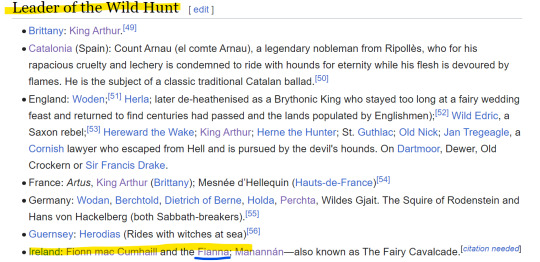
and We have a Fionn in Acotar.
Rhys’s eyes flicked to Ataraxia, then to Cassian. “Some strains of the mythology claim that one of the Fae heroes who rose up to overthrow them was Fionn, who was given the great sword Gwydion by the High Priestess Oleanna, who had dipped it into the Cauldron itself. Fionn and Gwydion overthrew the Daglan. A millennium of peace followed, and the lands were divided into rough territories that were the precursors to the courts—but at the end of those thousand years, they were at each other’s throats, on the brink of war.” His face tightened. “Fionn unified them and set himself above them as High King. The first and only High King this land has ever had.”
So the Morrigan is linked to Fianna which is the wild hunt and we have a Fionn in acotar who has the same name of the leader of wild hunt.
now onto...
Perchta:
Perchta or Berchta (English: Bertha), also commonly known as Percht and other variations, was once known as a goddess in Alpine paganism in the Upper German and Austrian regions of the Alps. Her name may mean "the bright one" (Old High German: beraht, bereht, from Proto-Germanic *berhtaz) and is probably related to the name Berchtentag, meaning the feast of the Epiphany. Eugen Mogk provides an alternative etymology, attributing the origin of the name Perchta to the Old High German verb pergan, meaning "hidden" or "covered". Perchta is often identified as stemming from the same Germanic goddess as Holda and other female figures of Germanic folklore (see Frija-Frigg). According to Jacob Grimm and Lotte Motz, Perchta is Holda's southern cousin or equivalent, as they both share the role of "guardian of the beasts" and appear during the Twelve Days of Christmas, when they oversee spinning.
so she is connected to Holda(keep the red highlighted Frija/Frigg part in mind we are gonna talk about that) and with that they both share the role of "guardian of the beasts"
We have beasts in acotar, in Wild Hunt actually.
“Oh, I do not think so,” Lanthys seethed. “I rode in the Wild Hunt before you were even a scrap of existence, witch from Oorid. I summoned the hounds and the world cowered at their baying. I galloped at the head of the Hunt, and Fae and beast bowed before us.”
“We shall rebuild to what we were before the golden legions of the Fae cast off their chains and overthrew us. We shall resurrect the Wild Hunt and ride rampant through the night. We shall build palaces of ice and flame, palaces of darkness and starlight. Magic shall flow untethered again.” Nesta could see the portrait Lanthys wove into the air around them. She saw herself on a black throne, a matching crown in her unbound hair. Enormous onyx beasts—scaled, like those she’d seen on the Hewn City’s pillars—lay at the foot of the dais. Ataraxia leaned against her throne, and on her other side … Lanthys sat there, his hand laced through hers. Their kingdom was endless; their palace built of pure magic that lived and thrived around them. The Harp sat behind them on an altar, the Mask, too, but the golden Crown wasn’t there.
“The Daglan delighted in terrorizing the Fae and humans under their control. The Wild Hunt was a way to keep all of us in line. They’d gather a host of their fiercest, most merciless warriors and grant them free rein to kill as they pleased. The Daglan possessed mighty, monstrous beasts—hounds, they called them, though they didn’t look like the hounds we know—that they used to run prey to ground before they tortured and killed them. It’s a terrible history, and much of it might be elaborated myths.” “The hounds looked like the beasts in the Hewn City,” Nesta said quietly.
so Hounds/beasts= The Wild Hunt and through Pertcha The Morrigan is connected to the "guardian of the beasts"
moving on...
This next part is interesting.
In some descriptions, Perchta has two forms; she may appear either as beautiful and white as snow like her name, or as elderly and haggard. In many old descriptions, Perchta had one large foot, sometimes called a goose foot or swan foot. Grimm thought the strange foot symbolized her being a higher being who could shapeshift to animal form. He noticed that Bertha with a strange foot exists in many languages (Middle German "Berhte mit dem fuoze", French "Berthe au grand pied", Latin "Berhta cum magno pede", Italian " Berta dai gran piè", title of a medieval epic poem of Italian area): "It is apparently a swan maiden's foot, which as a mark of her higher nature she cannot lay aside...and at the same time the spinning-woman's splayfoot that worked the treadle".In the Tyrol she appears as little old woman with a very wrinkled face, bright lively eyes, and a long hooked nose; her hair is disheveled, her garments tattered and torn.
I talked about Swan maiden in my Seidr post.
In myths Frejya/Frigg(remember the red highlighted part) has seidr magic and Freyja also has:
Freyja is the owner of the necklace Brísingamen, rides a chariot pulled by two cats, is accompanied by the boar Hildisvíni, and possesses a cloak of falcon feathers.
And swan maidens:
The swan maiden is a mythical creature who shapeshifts from human form to swan form. The key to the transformation is usually a swan skin, or a garment with swan feathers attached. In folktales of this type, the male character spies the maiden, typically by some body of water (usually bathing), then snatches away the feather garment (or some other article of clothing), which prevents her from flying away (or swimming away, or renders her helpless in some other manner), forcing her to become his wife.
So they have a "swan skin" with swan feathers which helps them shapeshift.
The question is...is Mor going to turn into a bird like the girls in Koschei's lake? Is she connected to Vassa? And more interesting thing is that in myths The Morrigan can shapeshift--into a crow.
The Morrígan is described as the envious wife of The Dagda and a shape-shifting goddess, while Badb and Nemain are said to be the wives of Neit. She is associated with the banshee of later folklore.
The Dagda...The Daglan in acotar who has the hounds and they had the Wild Hunt....
The Morrígan is mainly associated with war and fate, especially with foretelling doom, death, or victory in battle. In this role she often appears as a crow, the badb.
and lastly from Pertcha's page.
According to Jacob Grimm (1882), Perchta was spoken of in Old High German in the 10th century as Frau Berchta and thought to be a white-robed goddess who oversaw spinning and weaving, like the myths of Holda. He believed she was the feminine equivalent of Berchtold, and was sometimes the leader of the Wild Hunt.
Now I'm gonna talk more about Mor connection to Wild Hunt in acotar and some connections.
While talking about the hounds I took Lanthys's quotes. He was a part of the Wild Hunt.
“Oh, I do not think so,” Lanthys seethed. “I rode in the Wild Hunt before you were even a scrap of existence, witch from Oorid. I summoned the hounds and the world cowered at their baying. I galloped at the head of the Hunt, and Fae and beast bowed before us.”
But what is Lanyths actually? Cassian gives us this information. He is a First God.
Cassian took a bite of food. A good sign that this, at least, was acceptable territory. “When you lived in the human world, you had legends of the dread beasts and faeries who would slaughter you if they ever breached the wall, didn’t you? Things that slithered through open windows to drink the blood of children? Things that were so wicked, so cruel there was no hope against their evil?” The hair on her neck rose. “Yes.” Those stories had always unnerved and petrified her. “They were based on truth. Based on ancient, near-primordial beings who existed here before the High Fae split into courts, before the High Lords. Some call them the First Gods. They were beings with almost no physical form, but a keen, vicious intelligence. Humans and Fae alike were their prey. Most were hunted and driven into hiding or imprisonment ages ago. But some remained, lurking in forgotten corners of the land.” He swallowed another mouthful. “When I was nearing three hundred years old, one of them appeared again, crawling out of the roots of a mountain. Before he went into the Prison and confinement weakened him, Lanthys could turn into wind and rip the air from your lungs, or turn into rain and drown you on dry land; he could peel your skin from your body with a few movements. He never revealed his true form, but when I faced him, he chose to appear as swirling mist. He fathered a race of faeries that still plague us, who thrived under Amarantha’s reign—the Bogge. But the Bogge are lesser, mere shadows compared to Lanthys. If there is such a thing as evil incarnate, it is him. He has no mercy, no sense of right or wrong. There is him, and there is everyone else, and we are all his prey. His methods of killing are creative and slow. He feasts on fear and pain as much as the flesh itself.”(acosf)
So we learn quiet a few things from this quote.
Lantys is a first god.
First gods were near-primordial beings who existed before the High Fae split into courts, before the high lords.
They were beings with almost no physical form, but a keen, vicious intelligence.
But some First gods remained, lurking in forgotten corners of the land.”
Now how this connects to Mor? The Mor's acofas chapter.
In Mor's chapter we have this:
But Mor scented nothing, saw nothing. The tendril of power she speared toward the woods revealed only the usual birds and small beasts. A hart drinking from a hole in an iced-over stream. Nothing, except—.There, between a snarl of thorns. A patch of darkness. It did not move, did not seem to do anything but linger. And watch. Familiar and yet foreign. Something in her power whispered not to touch it, not to go near it. Even from this distance. Mor obeyed. But she still watched that darkness in the thorns, as if a shadow had fallen asleep amongst them. Not like Azriel’s shadows, twining and whispering. Something different. Something that stared back, watching her in turn. Best left undisturbed. Especially with the promise of a crackling fire and glass of wine at home. “Let’s take the short route back,” she murmured to Ellia, patting her neck. The horse needed no further encouragement before launching into a gallop, turning them from the woods and its shadowy watcher. Over and between the hills they rode, until the woods were hidden in the mists behind them. What else might she see, witness, in lands where none in the Night Court had ventured for millennia?(acofas)
She sees a shadows... and what we know about the first gods? with almost no physical form.
It stares back at her, watching her...and what we know about the first gods? but a keen, vicious intelligence.
She was in the lands where none in the Night Courth had ventured for Millennia... what we know about the first gods? lurking in forgotten corners of the land.
Did she saw a First God? Are there more like it? Why mor was the one to see it? This is where her connection to Wild Hunt comes from? She is connected to Wild Hunt? Maybe she is going to be the leader of the Wild Hunt?
Let's not forget that in Wild Hunt myth there are valkyries.
The Wild Hunt is a folklore motif occurring across various northern European cultures. Wild Hunts typically involve a chase led by a mythological figure escorted by a ghostly or supernatural group of hunters engaged in pursuit. The leader of the hunt is often a named figure associated with Odin in Germanic legends, but may variously be a historical or legendary figure like Theodoric the Great, the Danish king Valdemar Atterdag, the dragon slayer Sigurd, the WelshpsychopompGwyn ap Nudd, biblical figures such as Herod, Cain, Gabriel, or the Devil, or an unidentified lost soul or spirit either male or female. The hunters are generally the souls of the dead or ghostly dogs, sometimes fairies, valkyries, or elves.
and Mor in acosf suggested that she might join them.
Mor’s brows bunched. “So you really are learning Valkyrie techniques.” Nesta nodded. They’d been so busy during their dancing lessons that the details of training hadn’t come up. Mor grinned. “You mind if I start joining you once this business with Vallahan is over? I never got to train with the Valkyries before the first War, and after it, they were all gone.”
So Mor as the leader of the Wild Hunt?
#the Morrigan#acotar theories#acotar theory#this post was hell...I wrote all of it and accidently delete it#and then wrote all of it again and tumblr wouldn't let me save it as draft or post it#I had to find loopholes to save this post#so pls reblog and like it pls pls pls#anyways...I hope you all have a great day
28 notes
·
View notes
Note
Sorry if I’m yapping I’m just obsessed - sorry what ok continuing
Idk if you’re waiting reveal it or something but can you please say you’re fancasts (is it considered a fancast if you’re literally the creator? Or the half creator since it’s a reboot?) for your reboot?
I love eah fancasts / just fancasts in general and the way you’ve mentioned some of them in other posts makes me so curious
!!!!!
i never talk about my cast but here’s the list!!(i probably fucked up names on this, i have like five times)
these aren’t set in stone obv, and one of them is a joke bc i thought it would be funny if a certain someone played Rumplestiltskin-
Raven Queen played by Callie Haverda
Apple White played by Mckenna Grace
Madeline Hatter played by Momona Tamada
Briar Beauty played by Kyleigh Curran
Cedar Wood played by Maliah Baker
Ashlynn Ella played by Trinity Likins
C. A. Cupid played by Sarah Dorothy Little
Blondie Lockes played by Ava Kolker
Ginger Breadhouse played by Iman Vellani
Duchess Swan played by Rina Johnson
Darling Charming played by Clementine Lea Spieser
Farah Goodfairy played by Cheyenne Hinojosa
Cerise Hood played by Ashley Sarmentio
Daring Charming played by Tait Blum
Dexter Charming played by Jacob Tremblay
Sparrow Hood played by Dallas Young
Hunter Huntsman played by Mateo Gallegos
Humphrey Dumpty played by Issiah Russel-Bailey
Kitty Cheshire played by Miya Cech
Lizzie Hearts played by Sofia Chicorelli Serna
Alastair Wonderland played by Walker Bryant
Bunny Blanc played by Xochtil Gomez
Chase Redford played by Parker Bates
Courtly Jester played by Trixie Hyde
Meeshell Mermaid played by Sophie Grace
Jillian Beanstalk played by Brianni Walker
Hopper Croakington II played by Jentzen Ramirez
Melody Piper played by Oona O’Brian
Ramona Badwolf played by Symonne Harrison
She played by Izabella Rose
Poppy O’Hair played by Anais Lee
Holly O’Hair played by Mirabelle Lee
Brooke Page played by Pixie Davies
Gus Crumb played by Jace Chapman
Helga Crumb played by Camron Seely
Travis Thumb played by Amari O’Neil
Prudence Step played by Lilo Baier
Charlotte Step played by Ava Ro
Lily Bo-Peep played by Lotus Blossom
Zypherus Wynd played by Camren Conerly
Aquilona Wynd played by Trinitee Stokes
Charity Charming played by Kaylin Hayman
Clara Lear played by Scarlet Spencer
Mahlee Black played by Daria Johns
Coral Witch played by Michela Luci
Nathan Nutcracker played by Finn Little
Justine Dancer played by Priah Ferguson
Witchy Brew played by Pilot Saraceno
Nina Thumbell played by Ella Noel
Felix Princely played by Jackson Dollinger
Tucker Merry played by Miguel Cazarez Mora
Marsha King played by Alexa Nisenson
Jackie Frost played by Anya Taylor-Joy
Northwind Frost played by Logan Lerman
Milton Grimm played by Frank Whaley
Giles Grimm played by Kieran Mulroney
Baba Yaga played by Olga Kurylenko
Rumplestiltskin played by Danny DeVito
Pied Piper played by Collin Donell
Mad Hatter played by Paul Wesley or Alex Hefner
The White Queen played by Kate Winslet
Mr. Badwolf played by Con O’Neil
Momma Bear played by Nathalie Boltt
Papa Bear played by William Baldwin
Coach Gingerbread played by Hill Harper
Snowelle White played by Alison Brie
Elvira Queen played by Clemence Poesy
Good King played by Matt Lanter
Snow Queen played by Lisa Kudro
Snow King played by Jeffrey Dean Morgan
Lance Charming played by Dan Stevens
Bryce Frost played by Shailene Woodley
Pie played by ?
Butternut played by ?
Cheshire Cat played by Stephanie Hsu
Queen of Hearts played by Meghan Ory
White Rabbit played by Joe Arquette
Cook played by Olivia Hack
i have spent… so long thinking about my cast for this i would DIE if i got even half of these actors to play the characters in the reboot!!
16 notes
·
View notes
Text

Albert Göring, hermano menor del infame Hermann Göring en 1940. Como director de exportaciones de Škoda Works, usaría su posición y la reputación de su hermano para salvar a cientos de judíos durante la Segunda Guerra Mundial, así como para evitar cuatro arrestos y una orden de muerte.
Albert Günther Göring (Friedenau, Berlín, Imperio alemán, 9 de marzo de 1895-Berlín, Alemania Occidental, 20 de diciembre de 1966) fue un empresario alemán, hermano de Hermann Göring y conocido por haber sido un acérrimo opositor a las prácticas del gobierno nazi.
Nació el 9 de marzo de 1895 en el suburbio berlinés de Friedenau. Fue el quinto hijo de un funcionario del Imperio Alemán que se desempeñó como Reichskommissar (puede traducirse como Comisario del Imperio) de África del Sudoeste Alemana (hoy Namibia) y como Cónsul General en Haití, Heinrich Ernst Göring y Franziska "Fanny" Tiefenbrunn. Su padre descendía de una familia judía de origen suizo convertida al cristianismo y su madre provenía de una familia rural de Baviera. Entre los parientes de Albert pueden encontrarse a Ferdinand von Zeppelin, a la familia Merck —fundadores de la empresa farmacéutica Merck KGaA—, a los historiadores Herman Grimm y Jacob Burckhardt y la escritora Gertrud von le Fort.
La familia de Albert vivía aristocráticamente gracias a la herencia que les dejó Ritter Hermann von Eppenstein, que incluía los castillos de Veldenstein y Mauterndorf.
Sus hermanos fueron Olga Theresa, Karl Ernst, Paula Elisabeth y, el mayor, Hermann Wilhelm, quien llegaría a ser el Comandante Supremo de la Luftwaffe y mano derecha de Adolf Hitler.
A diferencia de su hermano, Albert se vio influido por su padrino, von Eppenstein, quien era un hombre de mundo de modales aristocráticos. Gracias a su padrino, se rodeó de los círculos más selectos y fue miembro de hermandades y sociedades civiles y empresariales. Se dedicó a ser empresario, a la tertulia y a las artes. En 1932 comenzó con una serie de cortometrajes sobre la caída del Imperio Alemán y la biografía de Guillermo II de Alemania, pero ante el ascenso del nazismo tuvo que abandonar su iniciativa por ser considerada socialista.
A partir de la llegada al poder de Adolf Hitler, Albert Göring comenzó a participar en las campañas en contra del gobierno del partido nazi.
En 1933 formó parte de la protesta por el cierre de la Escuela de la Bauhaus.
El mismo año, se opuso a la limpieza forzada de banquetas por parte de un grupo de mujeres judías. Cuando el oficial de las SS a cargo lo detuvo, al reconocer su nombre, no queriendo ser el culpable de la humillación pública del hermano de Hermann Göring, lo dejó libre e hizo detener la limpieza.2Cuando Alemania se anexó Austria, una de las primeras empresas en expropiarse fue la Tobis-Sascha-Filmindustrie, la compañía cinematográfica más grande del país, de la que Oskar Pilzer era el presidente. Éste fue detenido en enero y entregado a la Gestapo por su ascendencia judía y, como había sido jefe, maestro y amigo de Albert durante su corta carrera como cineasta, él lo ayudó en marzo a escapar consiguiéndole una identificación falsa.
Las actividades de Albert iban demasiado lejos y no eran toleradas por el partido nazi. Es así que Víctor Lutze, siguiendo órdenes explícitas de Hitler, lo encarceló durante dos meses en la prisión de Viena.
Cuando iba a ser enviado al campo de concentración de Mauthausen, su hermano Hermann intervino y, aprovechando su experiencia como empresario e industrial, lo ubicó como director de exportaciones de Skodovy Zádovy (división de ensamblaje de Škoda), en Checoslovaquia, con la intención de alejarlo del escenario político alemán.
Durante su estancia en Checoslovaquia sus actos se volvieron más radicales. Desde su llegada hizo todo lo que pudo para sabotear la maquinaria del Reich, fabricando vehículos defectuosos, retrasando o desviando pedidos, y entregándolos incompletos.
Existen anécdotas que cuentan que Albert llegó a falsificar la firma de su hermano en varias ocasiones para liberar prisioneros o conmutarles la pena de muerte; que enviaba camiones al campo de concentración de Theresienstadt demandando mano de obra forzada para después soltarlos; obtenía documentos oficiales para trabajadores judíos y así poder hacerlos pasar por checos; facilitaba especificaciones de los vehículos que fabricaba a la resistencia y demás actos contra el nazismo.
Este tipo de actos le valieron la persecución del partido nazi, que le negó las dietas a las que tenía derecho por ser familiar de un alto mando del partido.
En el otoño de 1943 firmó los pasaportes de una familia judía para que pudiera salir del país.
En otro momento convenció al jefe de las SS Reinhard Heydrich de liberar algunos prisioneros de la resistencia checa de los sótanos de la Gestapo.
Cuando en mayo de 1945 el Reich cayó definitivamente, Albert Göring fue detenido por los checoslovacos pero pronto fue puesto en libertad.
Tiempo más tarde fue llamado por las autoridades de la Ocupación Aliada en Alemania para ser juzgado en Núremberg. Acudió, primero, al Juicio de Oswald Pohl, en el que no se le condenó por falta de pruebas. También fue llamado al Juicio de IG Farben, donde aportó numerosos testimonios y una lista con 34 judíos a los que ayudó a escapar de la Gestapo, de las SS y de campos de concentración, y del que también fue absuelto.
A pesar de su ayuda, fue declarado culpable de haber obtenido una ganancia de 7.000 Reichsmarks en la fábrica Skoda con mano de obra esclavizada y condenado a dos años en la prisión estatal de Berlín, de donde salió en noviembre de 1947 encontrándose con que los bienes de la familia Göring habían sido embargados por el gobierno de Alemania Federal.
El encontrarse sin nada provocó un derrumbe en Albert, que se volcó al descuido y la bebida, sin llegar a conseguir un trabajo importante dentro de la Alemania Occidental. Trabajó como escritor, dibujante o traductor, pero siempre esporádicamente y muy mal pagado.
A pesar de los consejos de su amigo Ernst Kassler, Albert nunca accedió a cambiarse el nombre argumentando que aun sin su apellido, los Göring eran bien reconocidos en Alemania, Austria y Suiza, sin tener que presentarse.
En 1952, el gobierno alemán le concedió una pensión de 82 marcos alemanes mensuales ―equivalentes a unos 95 dólares actuales― por edad avanzada y desempleo. Desde entonces, y hasta su muerte, Albert vivió en un viejo apartamento en el centro de Berlín, con una casera con la que contrajo matrimonio pocos días antes de su muerte para que ella pudiera disponer de la pensión que el gobierno le otorgaba.
Albert Göring falleció el 20 de diciembre de 1966. Sus restos se encuentran en un cementerio en las afueras de Múnich
6 notes
·
View notes
Text
Hrothgar
Hrothgar is an Anglo-Saxon masculine name composed of hroth (fame) and gar (spear), cognate with Norse Hróðgeirr and Icelandic Hróðgeir.
Variants:
hrôđgâr [Jacob Grimm 1826 Deutsche grammatik, 2nd edition, 2: 462].
Hrothgar [Heinrich Meidinger 1833 Vergleichendes etymologisches Wörterbuch der gothisch-teutonischen Mundarten, 1st edition, page 518].
hrodgar [Heinrich Meidinger 1833 Vergleichendes etymologisches Wörterbuch der gothisch-teutonischen Mundarten, 1st edition, page 518].
Hrodear [Herbert Grueber 1893 A Catalogue of English Coins in the British Museum, Anglo-Saxon Series 2: 102].
Hróðgár [Northcote Toller 1882-1898 An Anglo-Saxon Dictionary, 2nd edition, page 563].
Hroðgar [Herbert Grueber 1893 A Catalogue of English Coins in the British Museum, Anglo-Saxon Series 2: 102].
Rodear [Herbert Grueber 1893 A Catalogue of English Coins in the British Museum, Anglo-Saxon Series 2: 123].
Rodgar [Herbert Grueber 1893 A Catalogue of English Coins in the British Museum, Anglo-Saxon Series 2: 123].
Hrōðgār [Patrick Hanks & Flavia Hodges 1990 A Dictionary of First Names, page 285].
Prototheme:
hroth = fame [Bill Casselman 2017 Word Stash, page 96].
Deuterotheme:
Gar = spear [Robert Ferguson 1883 Surnames as a Science, page 51].
Usage:
“Hrodear (= Hroðgar)” was the mark of a moneyer working for King Æthelstan II at Norwich: “✠HRODEAR HO ИORVC” [Herbert Grueber 1893 A Catalogue of English Coins in the British Museum, Anglo-Saxon Series 2: 112, number 74].
0 notes
Text
GRIMM’S FAIRY TALE: KUMPULAN DONGENG JERMAN YANG MENDUNIA [BAGIAN II]
(Ilustrasi buku dongeng Jerman) (Penulis artikel: Karunia Fitriarti) GRIMM’S BOOK Gaya penceritaan dalam kisah Grimm Brothers telah mengalami transformasi sedemikian rupa dari versi awal yang lebih kejam dan mengerikan menjadi sebuah dongeng yang lebih bersahabat untuk anak-anak. Jacob dan Wilhelm Grimm pertama kali mengumpulkan dongeng-dongeng yang mengeksplorasi realitas kehidupan…

View On WordPress
0 notes
Text
thinking about puck and his relationship with the grimms again, god i love them so much
thinking of RED and mr canis and their relationship with the grimms as well
#sisters grimm#sisters grimm mb#puck#relda grimm#jake grimm#jacob grimm ii#mr canis#little red riding hood
62 notes
·
View notes
Text
Why does no one like Uncle Jake
It makes me sad
14 notes
·
View notes
Text
"Wait for the Moon II."


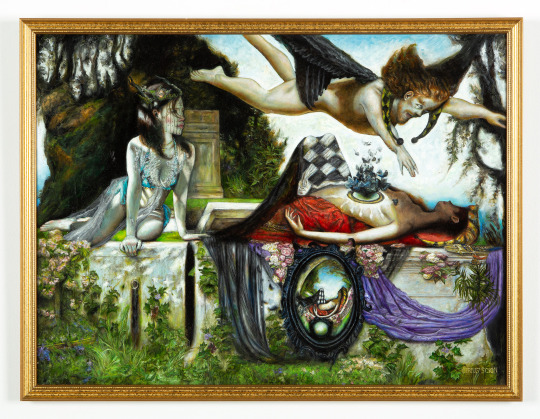

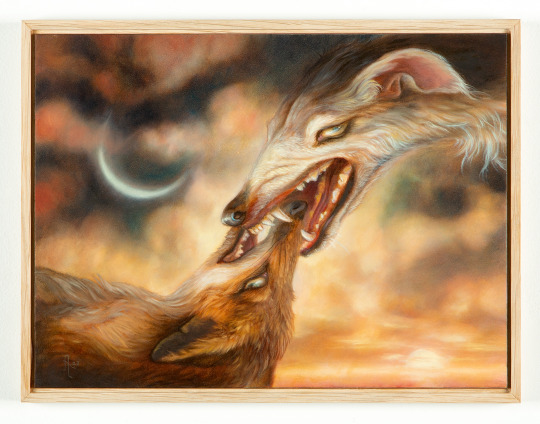
Opening on Friday, March 3rd, 2023 at Arch Enemy Arts in Philadelphia, Pennsylvania is the group exhibiton "Wait for the Moon II" which features works inspired by Grimms Fairy Tales.
More than two hundred years ago, German brothers Jacob and Wilhelm Grimm traveled Europe to collect, transcribe, and transform the oral folklore told for centuries before them. The stories, known as the Grimm’s Fairy Tales, have united a world of wondrous possibility with beauty, horror, violence, and magic for generations.
In this exhibition, twenty-five of the Grimms’ classic characters and beloved stories come to life in New Contemporary paintings, sculptures, and mixed media works. From the humorous to the melancholic, the whimsical to the macabre, we are captivated by the timeless enchantment artists have achieved in these fresh interpretations of the archetypal fantasy narrative.

THE SUPERSONIC ART SHOP | FOLLOW ON INSTAGRAM
35 notes
·
View notes
Photo

A bit of December 20th history...
1606 - The English colonial expedition to America departs London to found Jamestown, VA
1803 - French flag lowered in New Orleans to mark the formal transfer of the Louisiana Purchase from France to the US for $27 million
1812 - “Grimm’s Fairy Tales” or “Children’s and Household Tales” by Jacob and Wilhelm Grimm is 1st published
1860 - South Carolina declared an “independent commonwealth” and secedes from the Union - 1st state to do so
1922 - 14 republics form Union of Soviet Socialistic Republics (USSR)
1990 - The world’s 1st website and server go live at CERN
2007 - Queen Elizabeth II becomes oldest ever monarch of the UK, surpassing Queen Victoria who lived 81 years
2019 - United States Space Force founded, an armed forces branch dedicated to space warfare (pictured)
#history#anthropology#jamestown#louisianna purchase#grimm's fairy tales#sc secedes#ussr#cern#elizabeth ii#us space force
53 notes
·
View notes
Photo
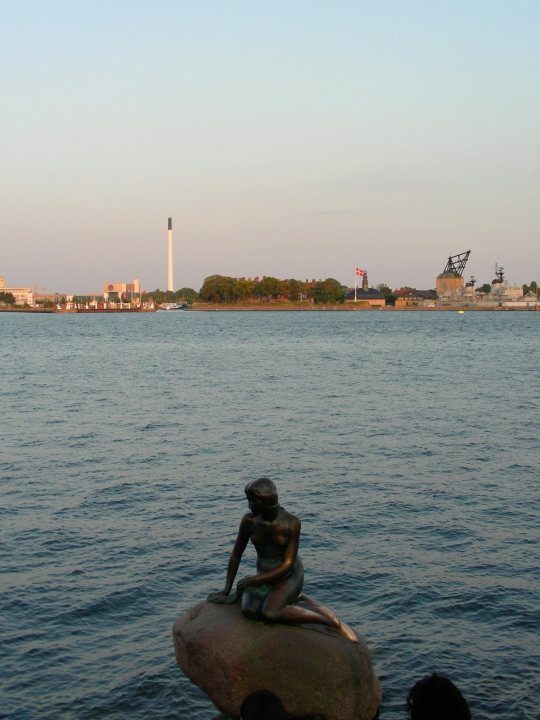

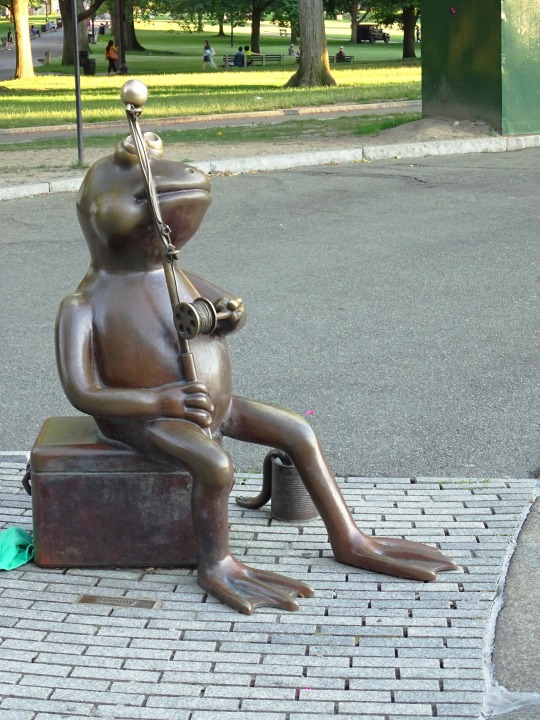
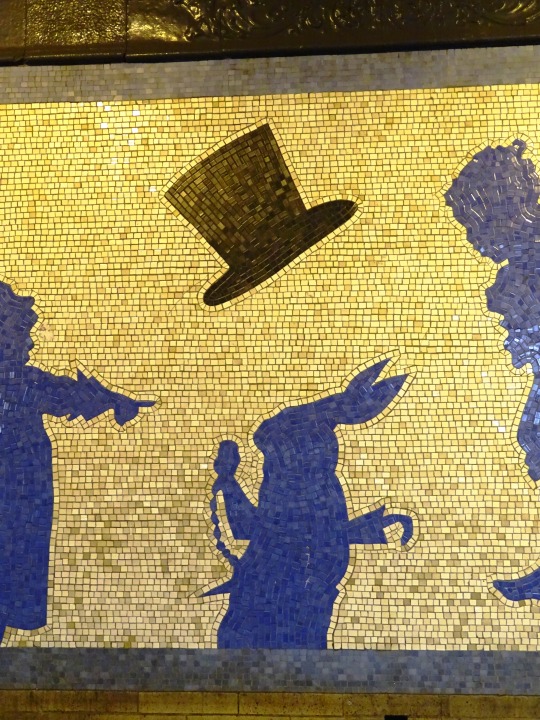






National Tell A Fairy Tale Day
Gather round the fire, and make yourselves comfortable… National Tell A Fairy Tale Day is all about exploring myths and stories, old and new. From grim(m) tales to urban legends, tap the dark corners of your subconscious and see what you find…
History of National Tell A Fairy Tale Day
The sharing of magical, otherworldly stories is a tale as old as time. While the term ‘fairy tale’ was coined in 1697 by Madame d’Aulnoy (conte de fées in her native French), it’s likely that some fairy tales originated as early as the bronze age over 6,000 years ago. And for most of history, fairy tales have been passed on not in written form but via the oral tradition, with each generation telling and dramatizing stories to the next.
The fairy tale’s ancient roots can be traced all over the world, from Vikram-Betaal in India and Aesop’s Fables in Ancient Greece to Arabian Nights in the Middle East. It was during the late 17th to 19th centuries that fairy tale collectors emerged, most famously Charles Perrault and the Brothers Grimm. While the Brothers Grimm aimed to preserve folktales in their pure form, documenting them in the way they were told by rural peasants unable to read or write, Perrault and others reworked fairy tales for literary and artistic effect, with some writers such as Hans Christian Andersen dreaming up their own new stories.
As the fairy tale’s history emerges into the modern day, it’s clear that the genre is still as popular as ever – look no further than the success of Disney movies to see how these stories continue to capture our hearts and imaginations. In fact, the famous Disney castle is inspired by Neuschwanstein Castle in Germany, built by none other than the Märchenkönig (fairy-tale king), Ludwig II of Bavaria, himself. Perched on a rocky hill and with horse-drawn carriage rides up to the front door, Neuschwanstein and its elaborate interior abound in myths and legends – the castle is even home to an artificial grotto!
By celebrating National Tell A Fairy Tale Day, you’ll be continuing the magical tradition that has ensured fairy tales are still very much part of our lives to this day.
National Tell A Fairy Tale Day Timeline
3000 BC – 1200 BC Fairy Tales get their beginning
During the Bronze Age, stories are passed down orally through Eastern and Western Indo-European languages. This includes stories such as Jack and the Beanstalk, Beauty and the Beast, as well as many others.
1697 Term “Fairy Tale” is coined
French literary fiction writer, Madame d’Aulnoy publishes her own book of Fairy Tales and is the first to use the term which, in French, is conte de fées. She is one of many female fairy tale writers during this era.
1697 Charles Perrault publishes his first book
This French author publishes a story collection that not only includes Little Red Riding Hood, but the grouping is subtitled as “Tales of Mother Goose”.
Early 19th Century Brothers Grimm popularize Fairy Tales
Jacob and Wilhelm Grimm are German academics who collect stories from German folklore and retell them. Many of these stories are similar to those of French storyteller, Charles Perrault, from a century prior.
1837 Hans Christian Andersen publishes The Little Mermaid
Included in the first collection of Fairy Tales Told for Children, which is published in Copenhagen, The Little Mermaid is probably one of the most popular of Anderson’s tales.
How fairy tales change over time
Perhaps one of the most interesting aspects of fairy tales is how they change over time. Simple plot structures, motifs and archetypal characters recurring across many cultures make these stories rife for adaptation and reinterpretation.
Although nowadays we usually associate fairy tales with children’s literature, you may be surprised to learn that many of today’s beloved stories have rather dark and disturbing origins. Imagine a world in which no woodcutter comes to save Little Red Riding Hood from the wolf’s belly, or in which one of the ugly stepsisters cuts off her own toes so that her foot fits in the slipper! From the 18th century onwards, many fairy tales were toned down and reworked so that they were more suitable for children.
These stories and the genre itself have also been adapted and reinvented for different time periods and cultures. Alongside original modern-day fairy tales, there are also various retellings, for example in urban settings or different countries. One particularly common type of retelling comes from women writers. Authors such as Angela Carter and Margaret Atwood have taken what are often seen as outdated tropes about women and reinvented them – the damsel in distress becomes the plucky heroine, and the trapped bride leaves her ogre husband for her happily ever after.
Why fairy tales are important
As it is often claimed Albert Einstein once said, “If you want your children to be intelligent, read them fairy tales. If you want them to be more intelligent, read them more fairy tales.” We might not expect such high praise for fairy tales from a world-famous theoretical physicist, but Einstein recognized the importance of the imagination. Fairy tales are incredibly valuable for both children and adults when it comes to learning about the world in which we live and developing our capacity for creativity. Fairy tales have also been considered fertile ground by psychoanalysts. With their twists and turns, age-old themes and familiar characters, our favorite stories may reveal not only the workings of our personal subconscious but also the fundamental elements of our collective psyche.
How to celebrate National Tell A Fairy Tale Day
It should be clear by now that, when it comes to celebrating National Tell A Fairy Tale Day, you really can let your imagination run wild! And while it’s a day that kids will love, it’s also a great occasion for adults too.
Gather your friends and family and take it in turns to share your favorite stories with one another. Time to brush up on your acting skills, as the more dramatic enactments the better – whether you’re good at impersonating a wicked witch or excel at acting out the characters’ quest through the enchanted forest, you’ll want to really make the tale come to life for your audience. And why not sit around a bonfire toasting marshmallows or string up some fairy lights in your living room to add to the atmosphere?
Alongside sharing the stories we know and love, fairy tales are the perfect genre for getting creative and honing your writing skills. Take a well-known story and tweak it to fit a different time or setting, or have a crack at inventing your own. It may well start with ‘Once upon a time’, but it’s completely up to you whether there’s a ‘Happily ever after’! Many libraries and literary organizations will also share stories and creative resources and even hold events to help mark the occasion.
If writing’s not your thing, then there are plenty of films and programs based on fairy tales for you to enjoy. Disney’s Snow White and the Seven Dwarves, Cinderella and The Little Mermaid are just some examples of the media giant’s adaptations, while movies and TV series such as Into the Woods and Tell Me a Story interweave and retell various classic fairy tales for new audiences.
And if you feel like going all out, why not host a fairy tale themed party? Encourage your guests to come in fancy dress, put on an enchanted feast of yummy snacks such as gingerbread houses and toadstool cupcakes, and throw some legendary party games like hunt the pea and castle building.
However you choose to celebrate National Tell A Fairy Tale Day, it’s sure to be a magical occasion!
National Tell A Fairy Tale Day FAQs
What is a Fairy Tale?
Also called wonder tales, magic tales or fairy stories, Fairy Tales are a genre of fiction originating in European folklore. These tales often feature mythical creatures such as elves, dwarves, giants, fairies, gnomes, mermaids and more.
Who wrote the first Fairy Tales?
The original stories were passed down orally for thousands of years so it’s impossible to tell who started them. However, some of the first Fairy Tales that were written and published were by French Authors Charles Perrault and Madame d’Aulnoy.
What are the most popular Fairy Tales?
A favorite part of many childhoods, some of the most popular stories of all time include Cinderella, Beauty and the Beast, Little Red Riding Hood, Snow White and the Seven Dwarves, Jack and the Beanstalk and Sleeping Beauty.
Which Fairy Tales are Grimm?
In the early 19th century, the Grimm Brothers spent time collecting stories from people of all classes in Germany. Some of their Fairy Tales include Cinderella, Snow White, Hansel and Gretel, Rapunzel, The Frog King, Rumplestiltskin and Little Red Riding Hood.
When is Tell a Fairy Tale Day?
Each year on February 26, National Tell a Fairy Tale Day is the perfect time to spend time reading and making up stories with children.
Source
#Hans Christian Andersen by Georg John Lober#Central Park#New York City#The Little Mermaid by Edvard Eriksen#Copenhagen#Denmark#travel#USA#vacation#Boston#Massachusetts#Boston Common#subway#sculpture#Frogs at Tadpole Playground by David Phillips#Alice The Way Out by Liliana Porter#Hare by Nancy Schön#National Tell A Fairy Tale Day#NationalTellAFairyTaleDay#26 February
2 notes
·
View notes
Text
Holidays 12.20
Holidays
Abolition Day (Réunion)
Bo Aung Kyaw Day (Burma)
Cathode-Ray Tube Day
Day of National Mourning (Panama)
Dot Your I's Day
Dot Your I's With Smiley's Day
Fête des Cafres (Abolition of Slavery Day; Réunion, French Guiana)
Fifty Ways To Leave Your Lover Day
Games Day
Go Caroling Day
Halcyon Days of Calm Seas begin
International Human Solidarity Day (UN)
Invocation of Molag Bal (Elder Scrolls)
Kitzmas
Louisiana Purchase Day
Make An Ornament Day
Mudd Day
Poet Laureate Day
Resilience Night
Ring of Troth Day
Sacagawea Day
SARE Day (Macau)
Tammasmass E'en (Orkney Islands)
Try to Remember Where You Hid the Christmas Gifts Day
Yuletide Lad #9 arrives (Bjugnakraekir or Sausage Pilferer; Iceland)
Food & Drink Celebrations
BPT Remembrance Day (Before Pop Tarts)
National Sangria Day
Pop Tart Day
Independence Days
Macau (Macau Special Administrative Region established, 1999)
Feast Days
Cheech & Chong Day (Church of the SubGenius; Saint)
Dominic of Silos (Christian; Saint)
Guyton Morveau (Positivist; Saint)
Hanukkah Day #2 (Judaism) [thru Dec. 26th]
Mōdraniht (Mother’s Night; Anglo-Saxon Pagans)
Mother Night (Beginning of Yuletide; Celtic, Pagan) [Begins at Sunset]
Not Frank Zappas Birthday (Pastafarian)
O Clavis (Christian; Saint)
Paul of Latrus (Christian; Saint)
Philogonius (Christian; Saint)
Pongol of the Sun (Hindu)
The Refined Young Cannonballs (Muppetism)
Swashbuckling Day (Pastafarian)
Ursicinus of Saint-Ursanne (Christian; Saint)
Katharina von Bora (Lutheran)
Yaldā (Iran; eve of the birth of Mithra) [Day before Winter Solstice]
Lucky & Unlucky Days
Fortunate Day (Pagan) [50 of 53]
Lucky Day (Philippines) [69 of 71]
Sensho (先勝 Japan) [Good luck in the morning, bad luck in the afternoon.]
Premieres
All That Jazz (Film; 1979)
Born on the Fourth of July (Film; 1989)
Concert for Bangladesh (Live Album; 1971)
Dreamgirls (Broadway Musical; 1981)
Everybody Plays the Fool, recorded by The Main Ingredient (Song; 1971)
Father of the Bride (Film; 1991)
Flaming Star (Film; 1960) [Elvis Presley #6]
The Girl with the Dragon Tattoo (Film; 2011)
The Godfather Part II (Film; 1974)
Grimm’s Fairy Tales (Book; 1812)
Hot Rocks 1964-1971, by The Rolling Stones (Compilation Album; 1971)
It’s a Wonderful Life (Film; 1946)
Ivanhoe, by Walter Scott (Novel; 1819)
Jumanji: Welcome to the Jungle (Film; 2017)
The Man with the Golden Gun (US Film; 1974) [James Bond #9]
Persuasion, by Jane Austen (Novel; 1817) [#6]
Rosamunde, by Helmina von Chézy with incidental music by Franz Schubert (Play; 1823)
Star Wars: The Rise of Skywalker (Film; 2019)
Two Weeks Notice (Film; 2002)
The Witcher (TV Series; 2019)
Today’s Name Days
Eike, Holger, Julius, Regina (Austria)
Ignat (Bulgaria)
Eugen, Julije, Makarije, Slobodan, Zefirin (Croatia)
Dagmar (Czech Republic)
Abraham (Denmark)
Pärja, Pärje (Estonia)
Benjamin, Kerkko (Finland)
Isaac, Jacob, Théophile (France)
Eike, Holger, Julius (Germany)
Ignatios (Greece)
Teofil (Hungary)
Liberato, Macario (Italy)
Abrams, Argods, Arta, Minjona (Latvia)
Daugardas, Gražvilė, Teofilis (Lithuania)
Abraham, Amund (Norway)
Amon, Bogumiła, Dominik, Liberat, Teofil (Poland)
Ignatie (Romania)
Dagmara (Slovakia)
Domingo, Eugenio, Teófilo (Spain)
Israel, Moses (Sweden)
Ammon, Roxana, Roxanne, Roxie (USA)
Today is Also…
Day of Year: Day 354 of 2022; 11 days remaining in the year
ISO: Day 2 of week 51 of 2022
Celtic Tree Calendar: Ruis (Elder) [Day 25 of 28]
Chinese: Month 11 (Dōngyuè), Day 27 (Ding-Wei)
Chinese Year of the: Tiger (until January 22, 2023)
Hebrew: 26 Kislev 5783
Islamic: 26 Jumada I 1444
J Cal: 24 Zima; Twosday [24 of 30]
Julian: 7 December 2022
Moon: 10%: Waning Crescent
Positivist: 18 Bichat (12th Month) [Guyton Morveau]
Runic Half Month: Jara (Year) [Day 11 of 15]
Season: Autumn (Day 90 of 90)
Zodiac: Sagittarius (Day 28 of 30)
2 notes
·
View notes